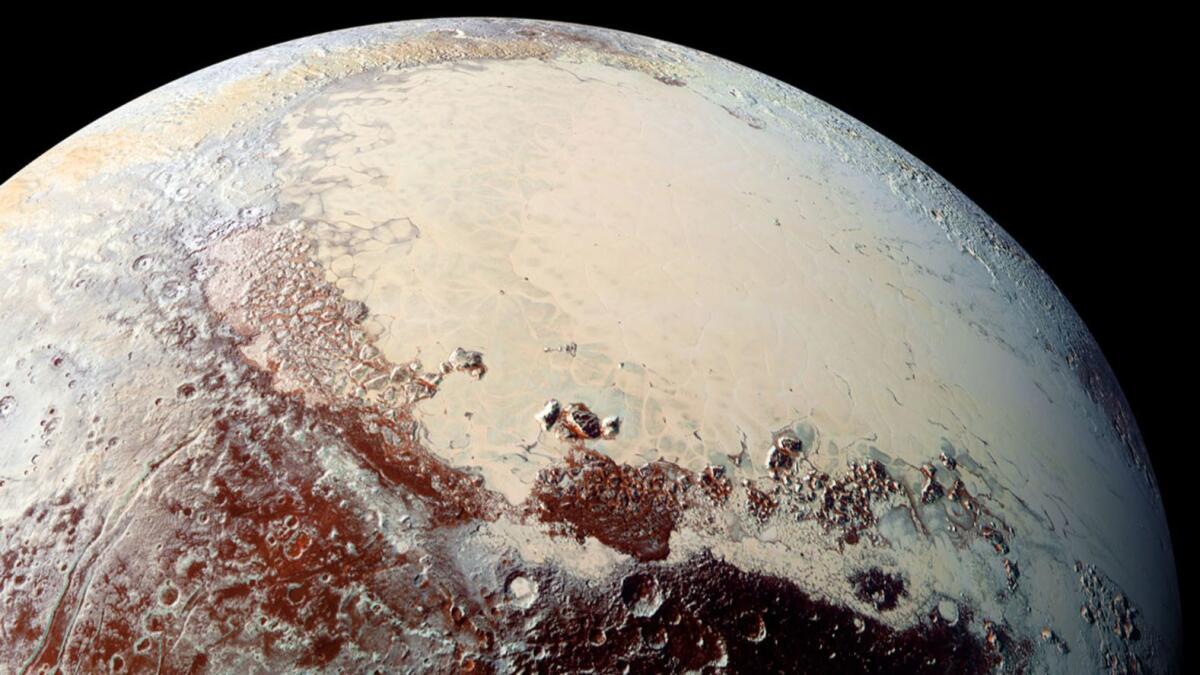Pluto’s heavy ‘heart’ may have led to depression. Seriously

Ever since NASA’s New Horizons spacecraft sent back the first high-resolution images of Pluto’s great white heart, scientists have been puzzling over its origin.
Some have suggested that the planet rolled over to ensure this particular feature wound up in this particular spot; others say its location could indicate a subsurface ocean. (You can read more about these hypotheses here.)
Now, a new study published Wednesday in the journal Nature suggests that the bright western lobe of Pluto’s heart-shaped basin is akin to an ice cap that formed on the coldest part of the dwarf planet, much like the ice caps that have formed on Earth’s poles.
“We’re used to thinking that planets have two ice caps on each of the poles, but Pluto only has one ice cap as far as we know,” said Douglas Hamilton, an astronomy professor at the University of Maryland who led the work.
Unofficially known as Sputnik Planitia, the western lobe of Pluto’s “heart” is located in a depression about 600 miles wide and covered in nitrogen ice that is 2.5 miles thick. It’s distinctive for being smoother and brighter than the rest of the surface.
It is also, intriguingly, located at what’s known as the tidal axis. This means that if you drew a line from the center of Pluto’s moon Charon through the center of Pluto and out the other side, you would come very close to where Sputnik Planitia is today.
Most researchers agree it’s no coincidence that Sputnik Planitia is situated on this particular spot. Indeed, if this geological feature were randomly placed on Pluto’s surface, there is only a 10% chance that it would wind up either facing the center of Charon directly or facing directly away from it, as it does today.
Charon and Pluto are tidally locked, which means both bodies always show the same face to each other. Amy Barr Mlinar, a senior scientist at the Planetary Science Institute in Tucson, explains it this way: “Charon always orbits above the same spot on Pluto as though the two bodies were joined by a rigid stick.”
This spot is almost directly opposite Sputnik Planitia, which suggests the frosty white feature has more mass than other parts of Pluto.
“The question we want to answer is why is there so much ice in this feature, why is it in a hole, and why is the hole and the ice located at 30 degrees latitude and 180 degrees longitude?” Hamilton said.
The authors of two other papers, also published in Nature, propose that the Sputnik Planitia basin is probably an impact crater, created when another body struck the dwarf planet in the latter days of solar system’s creation.
In their scenarios, the depression either fills up with ices and ejecta material, or causes an underground ocean to rise closer to the surface. Both possibilities would lead to more mass in this area than in other parts of Pluto, which in turn would cause the feature to migrate toward the equator over many millions of years in a process called true polar wander.
But Hamilton proposes an entirely different origin for the feature and its location.
According to his computer models, the thick ice buildup in the western part of Pluto’s heart was heavy enough to create the basin on its own, with no impact necessary.
“On Pluto, nitrogen ice weighs more than the bedrock, which is water ice,” he said. “If you lay that much nitrogen on top of the water ice, the ices make the hole by themselves.”
Do you want to hear that put more poetically?
“Pluto’s big heart weighs heavily on the small planet, leading inevitably to depression,” he said.
To explain why so much nitrogen ice accumulated in this particular area of the dwarf planet, he shows that due to the high tilt of Pluto’s spin axis, the coldest part of the mini-planet on average is around 30 degrees latitude — the same latitude where Sputnik Planitia happens to be.
But why did so much of the ice land in the heart-shaped feature rather than encircling Pluto in a band?
One possibility is that Sputnik Planitia was once the coolest part of the coolest latitude on Pluto — perhaps if it was in shadow or if its bedrock was especially bright, Hamilton said. This would cause more ice to be deposited in the area initially. Because the new ice is so bright, it would keep the area cooler by reflecting sunlight, thereby encouraging even more ice to accumulate.
There is still one more piece to explain, however: How did Sputnik Planitia come to be on Pluto’s tidal axis?
To answer this question, Hamilton takes us back to the early days of the solar system when a giant body crashed into Pluto, creating its largest moon, Charon. The massive impact would have caused Pluto to spin rapidly. However, over time — perhaps a million years — the spin rate would slow down to match the orbital rate of Charon.
If Pluto were a perfect sphere, it wouldn’t really matter what face it wound up showing Charon. But it isn’t a perfect sphere. Pluto’s single ice cap — Sputnik Planitia — is its dominant gravitational feature. (Picture a tennis ball with a clump of ice on one side.)
Therefore, as Charon and Pluto become tidally locked, the laws of physics dictate that the long axis of Pluto will face Charon with the elongating clump of ice either facing the moon or turning directly away from it.
“It’s like a slot machine with only one dial and a 50-50 chance,” Hamilton said.
It’s a cool hypothesis, but is there anywhere to test it? Will we ever know if it’s true?
Well, it would help if researchers could get another orbiter out to the dwarf planet to map its gravity field, Hamilton said, but that probably won’t happen for a long time. It is also possible that a close examination of faults and cracks on Pluto’s surface could provide clues to what geological forces have acted on the dwarf planet over time.
In the meantime, scientists will mull and argue over all the possible scenarios that might describe the origin of Pluto’s bright and heavy heart.
Do you love science? I do! Follow me @DeborahNetburn and “like” Los Angeles Times Science & Health on Facebook.
MORE IN SCIENCE
For a long life, consider picking up a tennis racket
NASA’s Cassini spacecraft is about to get a taste of Saturn’s rings
For high school football players, just a season of play brings brain changes







